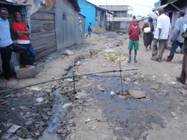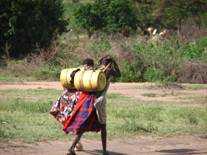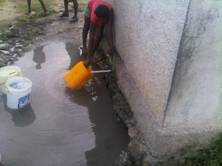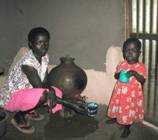NOTICE: This web page has been archived for historical purposes. Its content is no longer maintained, so information may be out of date and links may not work properly. For current Healthy Water features, please see the Newsroom, Features, & Observances page.
World Water Day 2011
 Each year, World Water Day attracts international attention to the conservation and development of freshwater resources. Learn about challenges to urban water management and what CDC does to address water issues around the world.
Each year, World Water Day attracts international attention to the conservation and development of freshwater resources. Learn about challenges to urban water management and what CDC does to address water issues around the world.
World Water Day is celebrated every year on March 22nd. In 2011, World Water Day focuses on urban water systems in conjunction with its theme "Water for Cities: Responding to the Urban Challenge". Learn more about the global challenges to urban water management and what CDC is doing to address water issues around the world.
Challenges to Urban Water Systems around the World
By the year 2050, about 70% of people in the world are expected to be living in urban areas [1]. Most of this shift from rural to city living is taking place in developing countries [2]. As cities grow, the demands for freshwater increase while the amount of water available for each person decreases. Currently, most megacities (those with 10+ million people) are located in parts of the world that already have water shortages because the demand for freshwater is greater than its availability [3].
Meeting the water needs of these fast-growing cities is challenging for governments and utility companies. Many existing water systems are poorly maintained and it is not unusual for more than half of the water to be lost to leakages and construction of illegal connections by non-paying users [3]. In addition, many consumers do not pay their water bills on time or do not pay at all, making it difficult for utility companies to provide reliable, continuous system operation and regular maintenance, and delaying expansion efforts.

River running through an informal settlement contaminated with sewage and garbage, Kenya.
Photo Credit: Elizabeth Blanton
Even in cities with well-developed public water networks, the water may not always be reliably safe to drink [4]. Many water systems deliver contaminated water either because of poor or intermittent disinfection practices or because the water becomes contaminated in the distribution network. Some systems only provide water for a few hours each day in order to ration scarce water resources. In these cases, when the water is not running, environmental waste and germs can leak into the pipes, causing further contamination. In addition, because of the inconsistency in water availability, many people choose to store water for use during times when the water is not running. Unfortunately, water can easily become contaminated if stored unsafely in open containers. Ensuring that water storage vessels are designed to prevent such contamination (e.g., covered and containing a spigot) can reduce the risk of contamination [5]. Water that is left stored in the open can even become a breeding ground for mosquitoes that carry diseases such as dengue fever. Individuals living in urban areas without clean water are at high risk for serious illness [3]. Recent cholera outbreaks in urban areas of Zimbabwe and Haiti have highlighted the public health consequences of deficiencies in drinking water supplies [6, 7]. For example, from October 23 through March 9, over 250,000 cases resulting in over 130,000 hospitalizations and 4700 deaths have been reported in Haiti [7].
Water plays a key role in many of the international development targets of the modern era* [3, 8]. Investments in water systems and water quality are essential to more than the physical health of a population. Improvements in the health of the poor through access to clean water and sanitation also increase opportunities for children to attend school and receive an education. Water availability and water quality are also essential for agricultural production, food safety, economic growth, reforestation and the natural environment's ability to withstand natural disasters. Progress toward many important development goals will suffer if access to water and sanitation is not improved, making clean water in cities a critical goal in achieving a healthier and more prosperous world.
*These development targets were set forth in the Millennium Development Goals (MDG), a pledge signed in 2000 by 189 Heads of State to "free our fellow men, women and children from the abject and dehumanizing conditions of extreme poverty" [8]. Learn more about MDG.

An illegal tap in an informal settlement, Kenya
Photo Credit: Elizabeth Blanton
CDC's Global Water, Sanitation, and Hygiene (WASH) Expertise
Inadequate water, sanitation, and hygiene (WASH) conditions exist in a range of settings, from temporary refugee camps to permanent homes in large cities.
CDC's global WASH program provides expertise and interventions aimed at saving lives and reducing illness by improving global access to healthy and safe water, adequate sanitation, and improved hygiene. The WASH program works on long-term prevention and control measures for improving health, reducing poverty, and improving socio-economic development as well as responding to global emergencies and outbreaks of life-threatening illnesses. These improvements reduce the lethal impact of WASH-related diseases ranging from cholera to typhoid fever to hepatitis.

Children carrying water home, Kenya
Photo Credit: Elizabeth Briere
CDC's global WASH work is focused in six areas and involves partnerships with Ministries of Health, non-governmental agencies, and various international agencies.
- Making Water Safe to Drink and Use: Promoting safe water through CDC's Safe Water System (SWS), which allows individuals, health workers, and schoolteachers to treat and safely store water in homes, health facilities, and schools, and Water Safety Plans (WSPs), which identify water quality threats in community water systems and water utilities, while implementing solutions to those threats.
-
Improving Hygiene and Sanitation: Improving the efficacy, sustainability, and integration of hygiene and sanitation interventions into communities and institutions such as schools

Woman getting water from a public water source, Haiti
Photo Credit: Katherine O'Connor - Responding to Complex International Emergencies and Outbreaks: Deploying emergency response and outbreak investigation teams at the request of foreign governments and U.N. agencies.
-
Controlling and Eliminating Disease: Identifying WASH-related factors needed to control or eliminate Neglected Tropical Diseases (NTDs) like Guinea worm disease, trachoma, and intestinal worm infections, which impact hundreds of millions of people around the world.

Safe water storage -- changing ways water is stored and protected in homes, Kenya. Photo credit: Rob Quick
- Identifying and Characterizing Disease: Investigating the causes of illness, such as diarrhea, to provide critical health data for decision making.
- Educating and Training about Global Water, Sanitation, and Hygiene: Developing model programs and materials for public health staff training and community health promotion.
References
- UN-HABITAT. State of the World's Cities 2008/2009-Harmonious Cities. Nairobi, Kenya: UN-HABITAT. 2008.
- UNFPA. Annual Report. UNFPA and IIED. U.a. IIED. 2009.
- World Water Assessment Program. The 3rd United Nations World Water Development Report: Demographic, economic and social drivers.World Water Development Report. UNESCO and Earthscan. Paris, France: UNESCO, and London, England: Earthscan: 2009.
- Lee, E.J. and K.J. Schwab, Deficiencies in drinking water distribution systems in developing countries. J Water Health, 2005. 3: 109-27.
- Mintz, E.D., F.M. Reiff, and R.V. Tauxe, Safe water treatment and storage in the home. A practical new strategy to prevent waterborne disease. JAMA, 1995. 273: 948-53.
- Cholera: Global Surveillance Summary, 2008. Wkly Epidemiol Rec. 2009 Jul 31;84(31):309-24.
- MSPP. Rapport de cas: Cholera.Journalier et Cumulatif: Donnees Preliminaires. Ministere de la Sante Publique et de la Population. 2011.
- United Nations. United Nations Millennium Declaration.UN General Assembly-8th Plenary Meeting. New York: 2000.
More Information
Get email updates
To receive email updates about this page, enter your email address:
Contact Us:
- Centers for Disease Control and Prevention
1600 Clifton Rd
Atlanta, GA 30333 - 800-CDC-INFO
(800-232-4636)
TTY: (888) 232-6348 - Contact CDC–INFO
 ShareCompartir
ShareCompartir


